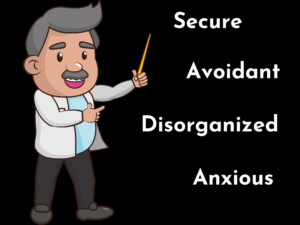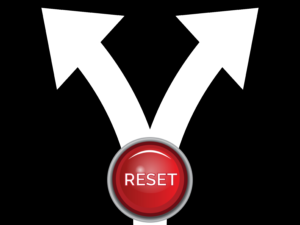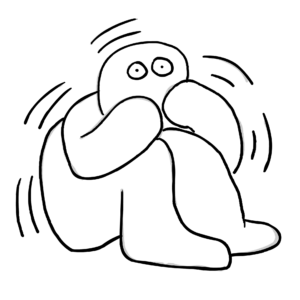

What does a healthy romantic relationship look like, and how do we create one? Do you struggle with finding that partner that you can deeply connect with? Do you find yourself in the same bad relationship over and over again? A healthy, secure relationship is something all of us can have. But first we need to get real with ourselves. We need to be healthy and secure as individuals.
Two healthy, secure people who enter into a relationship are like two whole circles. They already have what they need, and their partner only adds to the relationship. They don’t need anything from each other—they want to be together and their relationship adds to their abundance and fulfillment. This is what I call “falling in love”.
Two insecure people are like two half circles. They run around looking for someone to “complete” them. They need another person to fulfill a deficit they think they have. It’s more like an addiction to relationships disguised as love. What they are really doing is filling a need they are unable to provide for themselves. This is what I call “falling in lack”.
I am sure you are thinking, “Okay, but how does the half circle become a whole circle?”
One tool that I use in my coaching sessions is Attachment Theory, or Attachment Styles. If you Google this you can find all kinds of articles and lots of tests to see which style matches you the most. Another, related tool is Cognitive Flexibility, or the ability to shift from one task or one way of doing things to another. Your Cognitive Flexibility is related to your Attachment Style, and both influence how you move through the world and life.
Knowing your Attachment Style can help you on your journey to becoming that whole circle. Once you know where you are, you get to decide where you want to go. There are several Attachment Styles but they fall into two main categories: secure and insecure. The goal is to have a secure attachment with others in your life, and the good news is that you can change your Attachment Style!
History of Attachment Theory

Attachment theory deals with relationships and bonds—the relationship first between child and caregiver, then the relationships between romantic partners and friends. It was developed by John Bowlby in the 1950s, who studied the stress children go through when separated from their caregiver. Bowlby theorized that the relationships children develop with caregivers will have a huge impact on the rest of their relationships in life. When a caregiver responds to a child’s needs, the child learns that the caregiver is dependable and consequently has a secure base with which to explore the world.
Today there are four generally-accepted attachment styles: Anxious, Avoidant, Disorganized, and Secure. The first three styles are considered “insecure.” Most people would consider themselves a blend of at least two styles.
In the 1980s, Attachment Theory was expanded to include all relationships, not just the one between parent and child. Researchers began to look at the implications of different Attachment Styles on romantic relationships and even on work success., They noticed that relationships between child and caregiver have similar features as relationships between adult romantic partners.
Attachment Styles are Related to Cognitive Flexibility

Cognitive flexibility is generally defined as the ability to adjust behavior according to our environment. You can think of it as how well you change your behavior when something isn’t working, or when the rules or situation change. Some people settle into their behavior and become more rigid when challenged, but others adapt, changing their behavior to better suit the situation.
It turns out that humans can be pretty rigid in their beliefs and behaviors. One study tested monkeys versus humans and found that when monkeys were shown a more simple way to complete a task they immediately adapted it, while almost none of the humans did. The humans were much more rigid in their behavior and biased in their beliefs on how to accomplish the task.
A recurring theme I see with my clients is their lack of ability to handle challenges in a happy, healthy, and connected way. Instead, emotions kick in and they react to life like a pinball in a pinball machine. They get thrown, bumped, and spun as they react to all the things they can’t control such as people, traffic, or lines at the grocery store. Everywhere they go there is an emotional jolt, an immediate reaction which results in a limited number of ways to deal with the situation such as shut down, get loud, get frustrated, cry, plead, take control, talk in circles … all of which lead to similar outcomes.
Why the struggle with challenge? Why is it hard to move through and past these situations and why do we use the same reactive actions over and over to deal with them, even when we can see they don’t work? In short, how can we grow our Cognitive Flexibility?
To answer these questions we first have to know where we are. Where did we first learn how to deal with challenges? Who were our role models when we were learning to manage our emotions? We are products of our parents and our parents are the products of theirs and so on and so on. It is like we are on a giant merry go round and we are on it until we make the decision to jump off.
How does the parent-child relationship affect the adult? Turns out that our brains develop and change depending on what that relationship looks like. Makes sense—secure kids can explore their environment with curiosity and without fear, and that exploration grows their cognitive brain. A person who had a secure attachment with their caregiver can handle situations better, has lower levels of anxiety and depression, and is able to “roll with it.”
However, what happens in childhood is not the only influence on your Attachment Style. The attachment system that led to secure or insecure attachments of a child to its parent will also lead to secure or insecure attachment to a romantic partner, depending on how responsive their partner is to their needs. We start off looking through the lens of our childhood experiences, but eventually our adult relationships and experiences change the lens and “overwrite” our previous experiences.
Ok so let’s grow that half circle into a whole, complete human being!
Changing your Attachment Style and Growing your Cognitive Flexibility.
The first thing you need to know to know is where you are. What is your Attachment Style? Take a 4 minute test! Click here to access the ECR-R online test. And click here if you want to read more about the test. What were your results? Were you happy with them? If not, guess what … you can change it!
Most of us have some tendency to avoid or worry about our relationships. So how do we develop a secure Attachment Style, and why would we want to? Our Attachment Styles are important when it comes to forming happy, healthy and connected relationships. If you have an anxious/preoccupied Attachment Style and your partner has an avoidant Attachment Style, for example, you could be in for a very toxic relationship.
These Attachment Styles are deeply ingrained, but we can change them. Being human means we have the ability to learn, shift, adapt, and grow. With a good coach or therapist, tools, resourcefulness, and lots of practice you can reprogram your brain to think, do, and act upon what you want. Our Attachment Styles do not define us yet knowing what they are can help pinpoint specific challenges that, when overcome, would be a giant leap forward to creating more fulfilling relationships, raising secure kids, and growing your relationship with yourself. However, the shift from an insecure to a secure Attachment Style doesn’t happen overnight. It is a process. In coaching I call it a practice. It takes time and conscious effort … are you willing?
Once we know your Attachment Style, our job together would be getting to the root of where this behavior manifested. If you tested fearful/avoidant, for example, perhaps you had a parent who was critical, condescending, and judgmental. Maybe they compared everything you did with others, and nothing you did was good enough. Even though you get good grades, you aren’t active enough. You’re beautiful … except for that one blemish on your forehead. You were programmed to see every flaw as something ugly instead of learning to accept and love all of who you are. Because you weren’t loved unconditionally, you don’t love yourself. And you look for someone else to complete you.
This upbringing is the canvas from which you create. The canvas above is riddled with self doubt. It teaches you that you are unlovable. You want friends or a relationship, but people are scary—what if they hang out with you and learn that you’re not good enough, fun enough, pretty enough? You are not a complete circle!
This person is a perfect candidate for falling in lack. They feel alone and isolated, but want desperately to have someone in their life, so they will settle for the one who stays with them, even if it is toxic, because it’s better than being alone.
The truth is we were all born complete and whole, however, most of us have been programmed to believe we are not whole. This programming wasn’t done purposefully, it was done out of ignorance. While it doesn’t excuse the behaviors of caregivers or others in your life, it does give you permission to move past the neurosis that was cast upon you!
Cognitive Flexibility is key to changing our Attachment Styles

The parent in the above example had a fixed, inflexible mind. They were not willing to look at situations and problems in new and different ways. Cognitive Flexibility is the ability to be open and willing to try new ideas even if they are scary. This can feel like you are going against the grain of your body chemistry, and someone with a fixed mindset will say NO WAY, THAT’S NOT ME and instead come up with all the reasons why changing won’t work. A flexible, healthy mindset will say, okay I am willing to put myself out there and give it a go!
Can you recognize when you have a problem or situation that never gets resolved? Maybe you have the same argument over and over with your partner, or getting the kids to bed every night is a torturous process that leaves everyone wiped out and resentful. Maybe that weekly meeting at work never goes quite the way you want it to. Are you willing to try something new? Are you willing to hear another perspective?
Get Comfortable with Being Uncomfortable
 Image by Dmitry Abramov from Pixabay
Image by Dmitry Abramov from Pixabay
I know I know, being uncomfortable is … uncomfortable! We automatically try to fix a situation when we feel negative emotions like awkwardness, guilt, or resentment. Here is your challenge and a shortcut to increasing your Cognitive Flexibility and becoming more secure in your attachment. When you are uncomfortable, can you stay? Can you recognize when you are uncomfortable? Can you view the situation with curiosity? Can you be okay with your upset? Can you think of a new way to move forward if your current methods aren’t working?
Getting comfortable being uncomfortable is scary. But this is the space where real change can happen. A skilled coach will help you recognize when you are in an uncomfortable situation and help you stay on track when the going gets tough. When we learn to stay, assess the situation, and try new things we start to move through uncomfortable situations in a different, more productive way. This feels hard, maybe impossible, but remember that taking the easy way out in the moment gives you short-term results but leaves you with long-term pain. When you do the work, your short-term pain gives you long-term results. Excuses are a dime a dozen. Staying where you are, inflexible and unwilling, is a dime a dozen. Are you a dime a dozen?
You can take small steps every day to grow your Cognitive Flexibility and help prepare you for life’s uncomfortable moments. If you can become more flexible in your everyday life, you will be more prepared to stay aware and flexible in those uncomfortable moments where you are more emotionally charged. Some simple ways you can grow your cognitive flexibility are:
- Try something new. Try a new food or restaurant, see a movie or read a book that’s outside your normal genre, go to a play, a soccer game, or an art show.
- Alter your routine. Take a different route to work, try a new grocery store, or try a new workout.
- Meet someone new. Have a conversation with someone new at work, at the gym, at the park, or even in the line at the post office.
FYI the more secure your Attachment Style is, the easier it is to increase your Cognitive Flexibility. People who feel secure and safe have much less fear and anxiety when faced with a new situation. Bringing awareness to what your Attachment Style is and how it originated is key. AND working on your Cognitive Flexibility will help you develop a more secure Attachment Style. Challenging yourself in small ways, like driving a new route to work, can bring up feelings of fear, but as you challenge yourself more and more, you will lose the fear around trying new things.
Depending on how secure or unsecure you are, challenging yourself to try new things can be difficult! Coaching offers you new perspectives, tools, and support to keep you on track. Only you can release yourself—put the key in lock, open the door and walk out of your mind trap. But to do that you must first become aware of the trap you are in. This can be challenging to do on your own, but a good coach and a willing client can accomplish big changes in short periods of time.
Do something against the grain. Are you a minion who cares what everybody else thinks and spends all their time comparing yourself to everyone else or are you someone willing to step out and
BOLDLY
BE
YOU?
I Complete Me
When we grow our Cognitive Flexibility and develop more secure Attachment Styles, we no longer need someone else to complete us. We can enter into relationships from a place of security and confidence. We no longer fall in lack; we can fall in love.
Bretherton, I. 1992. The Origins of Attachment Theory: John Bowlby and Mary Ainsworth. Developmental Psychology. Vol. 28, No. 5, 759-775.
2Shaver, P. 1986. Being Lonely, Falling in Love: Perspectives from Attachment Theory.
3Hazan , C. and Shaver, P. 1990. Love and Work: An Attachment-Theoretical Perspective. Journal of Personality and Social 4Psychology. Vol. 59, No. 2, 270-280.
Watzek et al. 2019. Capuchin and Rhesus Monkeys but not Humans Show Cognitive Flexibility in an Optional-Switch Task. Scientific Reports NatureResearch. Published Online.




